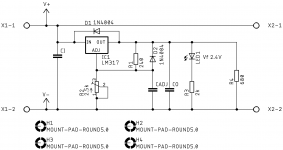LED dimming is usually accomplished by flashing them, easy enough to with a 555.
Please avoid doing this. Some folks happen to have a higher refresh rate with their vision and your blinking LED may annoy them. Some tail lights on newer cars appear more as a series of dots when I turn my head in any direction.
I have to avoid most brands of AC powered LED lights because they appear to be closer to strobe lighting.
Thanks
What about TV's and CRT's ?
If You flash a led higher than say 100Hz, You won't notice the flicker.
If You flash a led higher than say 100Hz, You won't notice the flicker.
Putting extra dummy led bulb in the panel and pushing back the original lit led bulb by bending the leads will work, isn't it ?
...100k resisistor ...Still to bright . I’m tgimkning half as bright again so can I assume 200k...
The eye is not linear. Also most folks misjudge "half".
Get a bundle all values from 100K to 1Meg and some jumper leads.
The eye is not linear. Also most folks misjudge "half".
"Half" is usually about 10 dB if I recall correctly.
Get a bundle all values from 100K to 1Meg and some jumper leads.
Or a potentiometer ... or a 555 timer IC.
Tom
Please avoid doing this. Some folks happen to have a higher refresh rate with their vision and your blinking LED may annoy them. Some tail lights on newer cars appear more as a series of dots when I turn my head in any direction.
I have to avoid most brands of AC powered LED lights because they appear to be closer to strobe lighting.
Thanks
Me too! Especially LED Christmas lights... Would it be THAT expensive to include a bridge and cap?! I find the same thing with magnetic fluorescents...
Hello,
I want to design a small led dimmer pcb for the front panel of an amplifier to adjust brightness for supply voltage in the range of 12 V to 24V.
I came up with attached circuit, Load resistor R4 can be adjusted to have min load current of say 6-10mA.
If V out at regulator is adjusted from 4.4 V to 14V, the current through LED can be varied from 1mA to 6 mA.
Will this work?
I want to design a small led dimmer pcb for the front panel of an amplifier to adjust brightness for supply voltage in the range of 12 V to 24V.
I came up with attached circuit, Load resistor R4 can be adjusted to have min load current of say 6-10mA.
If V out at regulator is adjusted from 4.4 V to 14V, the current through LED can be varied from 1mA to 6 mA.
Will this work?
Attachments
Anyone working with LEDs should know the simple formula: (Ubat - Ufled)/Iled = Rled. You can do it complex with a lot of stuff but it really requires just 1 (one) resistor. When fed AC you'll need some extra parts to protect the LED and also avoid flickering. With modern green, red, amber LEDs Uf of the LED is around 1.8V and current for normal brightness is about 2.5 mA. With blue, white and purple LEDs Uf is 3...5V depending on color and brand. You are safe to use 4V in calculations. Current for those is already high at 1 mA! The trouble is that those terribly annoying blue/white LEDs are way too bright even at very low currents. They will give your DIY device cheap Chi-Fi looks which is a choice 🙂 A soft glowing green one is more easy to many eyes and it won't light up the whole room. It will just show that the device is being powered on, no more no less.
*If choosing blue/white/purple always search for diffused ones, the clear types are simply search lights.
*If choosing blue/white/purple always search for diffused ones, the clear types are simply search lights.
Last edited:
*If choosing blue/white/purple always search for diffused ones, the clear types are simply search lights.
The diffusion helps with blurring the point source of the emitter inside the LED, but the primary factor affecting the amount of light "projected" in any one direction is the LED's viewing angle as stated in the datasheet. A wider angle will reduce the apparent brightness when looking directly at the LED and will be more visible (and look better) from the side.
Hal
- Home
- Amplifiers
- Power Supplies
- LED Dimming
